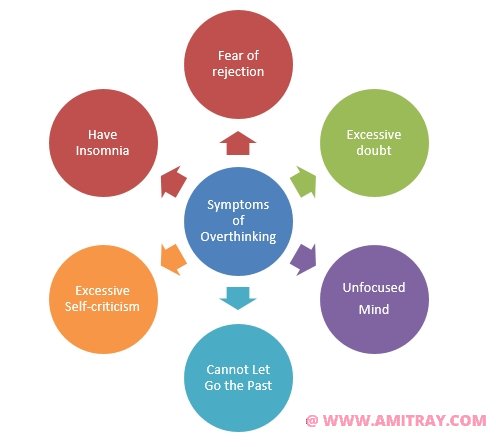Are you thinking excessively and want to stop that? Here is ten simple techniques to stop overthinking. You should also know the neuroscience of overthinking.
in this article, we explain ten most popular techniques to overcome overthinking.
Overthinking and negative thought patterns drains away the positive energy from life. What is most important for healthy, happy and successful life is to learn to cut-off the negative thought patterns from the source (the triggers) as early as possible.
The mind does not like to change its thought patterns. Normally, human subconscious mind is a habit mind. It repeats the same habits over and over again. Unhealthy thought patterns create stress and stress creates unhealthy biological reactions, and prolonged stress can lead to both physical and mental health problems. Fortunately there are many ways to come out of the unhealthy thought patterns and overthinking.
Neuroscience for Overthinking:
Generally, your overthinking habit patterns mostly develop from the behavior of our parents, teachers, spouse, friends, relatives, office colleague and children. If you work under stress, fear and insecurity for long time an area in your brain called the dorsolateral prefrontal cortex (dlPFC) became hyperactive. The dlPFC is involved in things like thinking, planning, memory, reasoning and higher executive function.
There are two main memory systems in our brain: long-term memory and the short-term memory (or working memory). Our long-term memory system helps us remember information and events from the distant past, whereas something called “working memory” helps us keep things in mind as we actively work with them. The dlPFC area of our brain is associated with the working memory. Working memory is critical for us to solve problems effectively and manage chunks of information in the present.
In high-pressure situations, the dlPFC) became hyperactive. When this system is not operating at normal levels, it can lead to mistakes, difficulty completing tasks in a desirable way, difficulty concentrating on a variety of things, and problems.
Overthinking and the default mode network
We have two opposed brain networks: the default mode network (DMN) and the executive attention network (EAN). When your unconscious mind thinks that something is unresolved, it brings DMN to the fore whenever it feels that you have time to resolve it. This is called the Default Mode Network of the brain. When you are not present in the context, the brain goes into default mode which includes personal memories, daydreaming, sleeping, imagining the future, and trying to take the perspective of others.
In contrast, the EAN network is thought to be involved when our attention is directed outward. When people were reasoning about mechanical objects, the EAN brain network was activated and the DMN network was suppressed. In contrast, when people were engaged in social reasoning, the DMN network was active and the EAN network was supressed. Switching of the brain networks depends on what kinds of mental representations are necessary for survival.
Six Common Symptoms of Overthinking:
Overthinking eats away from the inside. It clouds the minds, judgment and destroys any semblance of happiness. It rots away at the brain and keeps it in a perpetual state of paralysis. The six key symptoms of overthinking are: fear of rejection, excessive doubt, unfocused mind, cannot let go the past, excessive self-criticism, and insomnia.

Six Key Symptoms of Overthinking
All of our actions in the world begins with our thoughts and, when you deliberately change the way you are thinking, you can create the life of your dreams. But because our thinking habits are so deeply ingrained in our sub-consciousness mind, sometimes it is not so easy to change and then we need some assistance.
10 Powerful Techniques to Overcome Overthinking
1 Positive self-talk
Positive self talk, is more about re framing your mindset and views about the world, removing negative bias, and approaching life with the idea that you can tackle things and solve problems. Moreover, if things don’t go perfectly, you’ll learn from it for the next time.
In the morning you can say, ‘Today is going to be a great day.” Visualize your day going perfect in detail. Focus your energy on what you want to do. Write down the goals that you want to accomplish. Be diligent, consistent and positive.
2. Growth Mindset
The growth mindset promotes resilience while the fixed mindset one does not. Growth mindset embraces challenges easily with positive views. Growth mindset can serve as a protective factor against psychological problems, such as depression, behaviors problems, school disengagement, and burnout. It gives confidence that abilities can improve through hard work and persistent learning.
3. Learn to be present in everything you do
True happiness can only be found in the present moment. You need to learn how to live in the moment and stop worrying about the past or future. Because most humans spend more time focusing on the adverse consequences (because of the pain pathway in the brain), we develop dominant negative thought patterns that keep us stagnant and are the basis of our self-fulfilling prophecies coming true.
4. Balance your thought patterns

Balance your thought patterns – Amit Ray
Learn to take a closer look at your thoughts, and coming up with more balanced and realistic thoughts, is the key tool for for managing your thought patterns. The aim is to make positive thought patterns as habit and part of your subconscious mind.
Negative thought patterns impact your work, finances, and relationships in a bad way. Many people also trick themselves with negative feelings – firstly they do not aware about the negative thought patterns and secondly they do not know the ways to come out of those negative thought patterns.
A negative mental state is when you feel stressed out, worried, frustrated, angry, depressed, irritable, overwhelmed, resentful or fearful.
A positive mental state is when you feel love, joy, gratitude, awe, playfulness, ease, creativity, drive, caring, growth, full with curiosity and appreciation.
Just witness your thought patterns. According to National Science Foundation, an average person has about 12,000 to 60,000 thoughts per day. Of those, 80% are negative and 95% are repetitive thoughts. Thoughts are like a river goes on moving, zigzag.
5. Know the events, thoughts, and the people that irritates you
Whether it is gossip, criticism or unkind remarks, your mouths can be instruments of righteousness or unrighteousness. Know the events, thoughts, and the people that irritates you. Close that door. Guard your everyday thinking, words and actions consciously. Think about things that are pure and lovely and admirable. Think about things that are excellent and worthy of praise.
6. Be playful and learn to lough
Learn to smile and laugh whenever possible because that improves immunity. Playfulness can free your mind and help you to find ideas or solutions seemingly impossible using pure logic. This can help you to overcome creative blocks and manage criticisms. Playfulness not only stimulate unique ideas but also cultivate a sense of community and love. It cultivates a psychologically safe environment where mistakes are valued, risk-taking is encouraged, and everyone can be playful without concern for propriety or contrived politeness.
7. Go outside and stay in touch with nature
Nothing makes you shut up and clear your thoughts like a hike through the forest or a bike ride through the city. Get out, get the heart pumping a little bit. Treat it like meditation. You’re not trying to clear your mind, but let your thoughts roll through your head at their own pace. Don’t force anything.
8. Change your breathing pattern
During overthinking and stress, our breathing rate and pattern change. The idea is to learn what an ideal pattern for you and then become mindful of how you breathe in different situations. If required tweak your pattern when needed. Stand in front of a mirror. Breathe in and see what happens. Your torso should expand slightly, but your chest and neck should stay fairly relaxed.
9. Do regular yoga exercises
Morning yoga can help you kickstart your day in a positive way. Yoga does more than just burn calories and tone muscles. It’s a total mind-body workout that combines strengthening and stretching poses with deep breathing and meditation. You can practice Surya Namaskar, they’re a great way to warm up and start to sync movement of the body with the flow of the breath.
10. Practice meditation
Meditation is often misunderstood as a strict practice of clearing your mind completely. You can try it that way, there’s nothing wrong with that, but the best type of meditation for overthinking is meditation that allows your thoughts to roll pleasantly through your mind.
You don’t need to sit down in the dark places. Just pick any safe place or any time. Close your eyes, sit and quietly breath in and out at an even pace. Focus on the sound of your breath – or watching the colors you see in the backs of your eyelids. See how quiet you can get your head to become. When you meditate, you grow more grey matter, stimulate new neuronal growth and quiet your brain stress center significantly and reduces overthinking.
Summary
We discussed ten top techniques to overcome overthinking. Excessive overthinking drains away the positive energy from life. Normally, our subconscious mind develop these overthinking habit patterns. Unhealthy thought patterns create stress and stress creates unhealthy biological reactions, and prolonged stress can lead to both physical and mental health problems. Fortunately there are many ways to come out of the unhealthy thought patterns and overthinking.
